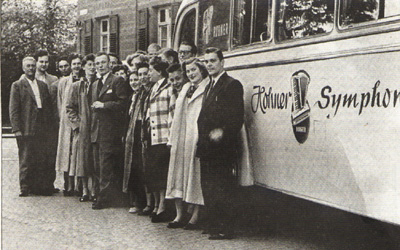 |
 |
| Rudolf Würthner
is most famous for being the Director of the Hohner Akkordeon-Orchester
1927 Trossingen e.V. which was originally started by Hermann Schittenhelm
(born 1893), who directed the orchestra for 22 years. One of his students,
Rudolf Würthner was to be his successor as orchestra leader and both
wrote educational and concert pieces for the accordion. Rudolf Würthner was a student at "Städtische Musikschule Trossingen" and at the "Hochschule für Musik" in Stuttgart. He then became a teacher at the "Städtische Musikschule Trossingen" from 1939 to 1942. He was a superb solist and at the 1948 Coupe Mondiale in Lausanne, Switzerland, he was placed 2nd with Yvette Horner of France winning 1st place and David Anjzaghi of Italy in 3rd place. All three were destined to become very very famous names in the accordion industry.  Rudolf
Würthner was the conductor of "Orchester des Hauses Hohner"
from 1947 to 1963 and took over as Director of the Hohner Akkordeon-Orchester
in 1968. Already, this orchestra was a triumphant and legendary success.
Würthner saw his task as increasing the popular tradition of the
orchestra with improved concert music, greater repertoire and more popular
music, to increase appeal to the layman. Rudolf
Würthner was the conductor of "Orchester des Hauses Hohner"
from 1947 to 1963 and took over as Director of the Hohner Akkordeon-Orchester
in 1968. Already, this orchestra was a triumphant and legendary success.
Würthner saw his task as increasing the popular tradition of the
orchestra with improved concert music, greater repertoire and more popular
music, to increase appeal to the layman.These initiatives combined with his artistic creativity entailed an audible jump in the quality of the orchestra. In numerous concerts, radio broadcasts and television appearances as well as the participation in international festivals, the orchestra won the highest of acclaim. An excerpt from the "The History of the Accordion in New Zealand", author Wallace Liggett gives an indication of the enormous impact achieved by Würthner and the Hohner Akkordeon-Orchester in New Zealand and without doubt in many other parts of the world. "In 1957, Auckland, Wellington and some other centres received a visit from the Hohner Accordion Symphony Orchestra. This well disciplined and musically expressive group opened many eyes to yet another dimension of the accordion. Among their concert repertoire were such works as Hungarian Rhapsody No. 2 (Liszt), Invitation to the Dance (Weber), Dance of the Hours (Ponchielli), and included their conductor Rudolph Wurthner, playing La Campanella accompanied by the orchestra. This was the first time that New Zealanders had heard an accordion orchestra perform full score transcriptions of orchestral works. Another first was the use of timpani, amplified bass and cello accordions plus the tasteful use of electronics with acoustic reed accordions, a feature that has rarely been explored as fully even to this day. This concert tour inspired the formation of a number of accordion groups and orchestras in New Zealand." Unfortunately this enormous success story lasted only six years. In the midst of these new tasks, Rudolf Würthner suddenly died - a sad, painful finale for a co-operation, which carried so many hopeful expectations of an every increasing fame and increasing quality of music for accordion. Today, Rudolf Würthner is remembered annually with the prestigious Rudolf Würthner Musikpreis run by the DHV of Germany. His works for accordion have long survived him. - Fantasia from "Carmen", after Georges Bizet, 1951 - Variations on a Russian folk song, 1951 - Moderato-Allegretto scherzando, 1957 - Moderato-Allegro assai, 1957 His arrangements for accordion orchestra continue to be extensively used. For example, in 2005, the Hohner Akkordeon-Orchester 1927 Trossingen e.V. held a concert featuring only Würthner compositions and arrangements. His memory through his music abilities and the musical traditions of the Hohner Akkordeon-Orchester have lived far beyond his sadly short life. |
|
©
Copyright 2005 Accordions Worldwide. All rights reserved
|
